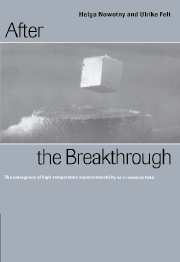Book contents
- Frontmatter
- Contents
- Acknowledgments
- 1 Introduction: the emergence of a new research field
- 2 The context of the discovery
- 3 Reconfiguring actors and knowledge: the organization of a new research field
- 4 Academic research, science policy, and the industrial connection: setting up national high-temperature superconductivity programs
- 5 Science and the media: newspapers and their “HTS story”
- 6 The innovation machinery of science: the case of HTS
- Appendix 1 Main events in the history of superconductivity before the discovery by Müller and Bednorz
- Appendix 2 Chronology of important events in high-temperature superconductivity in the early phase
- References
- Index
3 - Reconfiguring actors and knowledge: the organization of a new research field
Published online by Cambridge University Press: 02 December 2009
- Frontmatter
- Contents
- Acknowledgments
- 1 Introduction: the emergence of a new research field
- 2 The context of the discovery
- 3 Reconfiguring actors and knowledge: the organization of a new research field
- 4 Academic research, science policy, and the industrial connection: setting up national high-temperature superconductivity programs
- 5 Science and the media: newspapers and their “HTS story”
- 6 The innovation machinery of science: the case of HTS
- Appendix 1 Main events in the history of superconductivity before the discovery by Müller and Bednorz
- Appendix 2 Chronology of important events in high-temperature superconductivity in the early phase
- References
- Index
Summary
The emergence of HTS as a research field is an example of how positing a situation can make it real. Discourse and beliefs, rhetoric and persuasion, and a vision of a bright technological future – hardly supported by reliable facts at the time – acted as a catalyst. As the concept of “windows of opportunities” suggests, when new technologies appear on the market, new opportunities suddenly seem to exist, but the period in which they can be realized and exploited is brief (Perez, 1983; 1989). In the end, unsurprisingly, there are winners and losers. But while institutions maintained their structural grip and while path dependence and varying degrees of preparedness had their effects, for a short, compressed time, scientists' vision and rhetoric, policy constructs and persuasion succeeded in collusively reshuffling some of the more inert parts of the science system, before they resettled into the familiar pattern of institutional stability.
The emergence of a new research field underscores that the science system is not set once and for all; knowledge of its history is thus an essential prerequisite for understanding it: “The passage of time, and changes it brings in the factors and phenomena that interest us, are our single best resource” (MacKenzie, 1990: 7). The study of a process of change is hardly in danger of mistaking a moment for an eternal condition. But it is difficult to distinguish a unique event from more enduring developments that permit generalization. The participants we interviewed, the institutions we visited, the situations and choices reported to us, and above all the state of scientific and technological knowledge continue to change.
- Type
- Chapter
- Information
- After the BreakthroughThe Emergence of High-Temperature Superconductivity as a Research Field, pp. 44 - 71Publisher: Cambridge University PressPrint publication year: 1997



